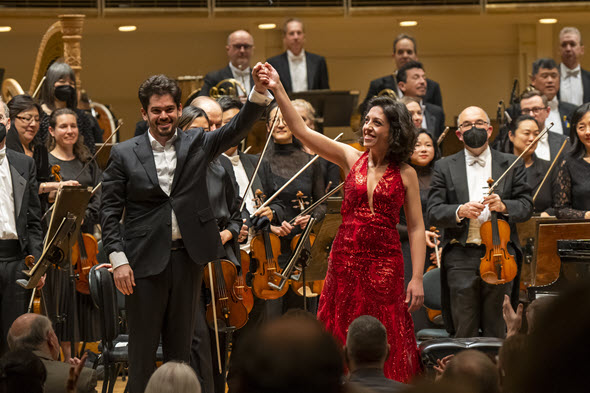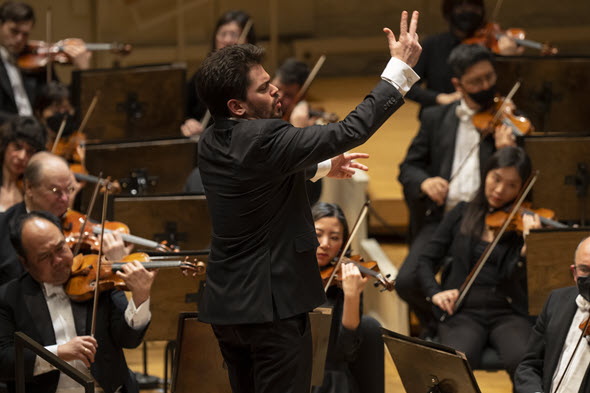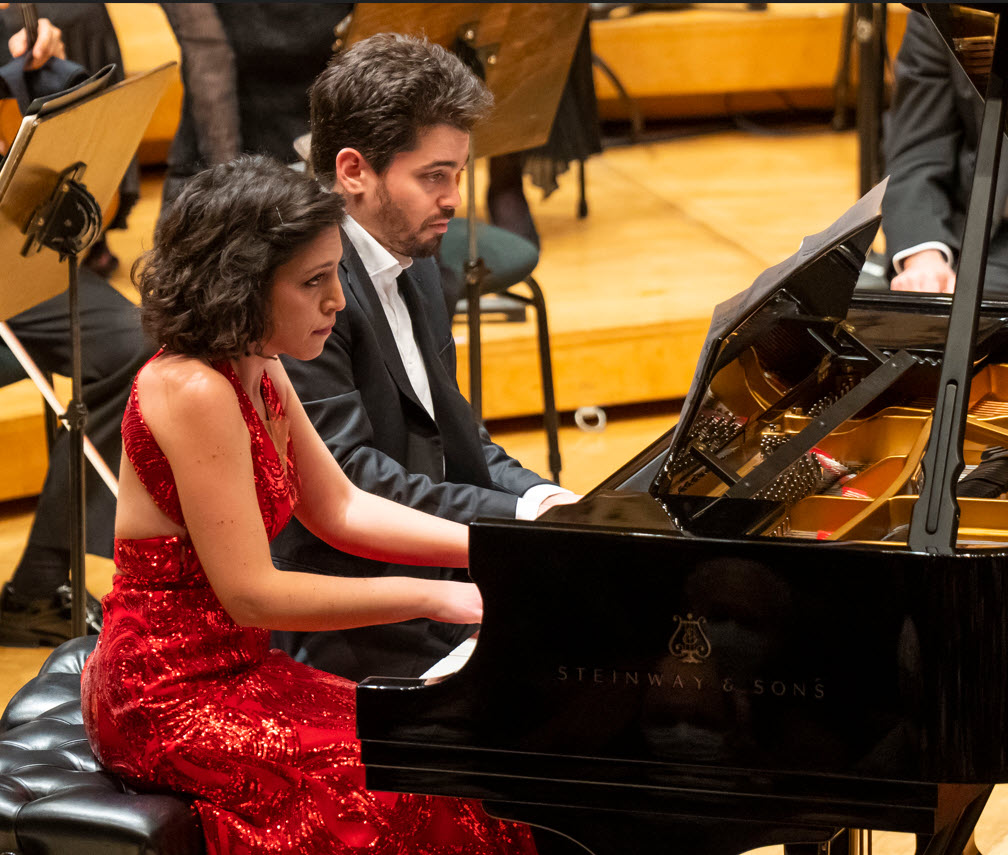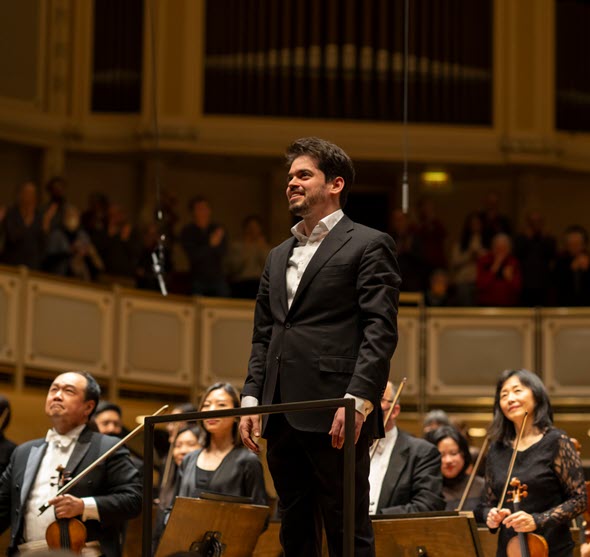In dazzling debuts with Chicago Symphony, conductor and pianist renew Russian masters

Israeli conductor Lahav Shani, 34, and Italian pianist Beatrice Rana, 30, made Chicago Symphony debuts Feb. 9 in a lively concert of Russian music. (CSO Photos by Todd Rosenberg)
Review: Chicago Symphony Orchestra conducted by Lahav Shani; Beatrice Rana, piano. Feb. 9 at Orchestra Hall.
By Nancy Malitz
However appealing the idea of two cross-country trips may seem to those who’ve been cooped up too long, the Chicago Symphony Orchestra’s January-February itinerary under stressful Covid conditions looked exhausting to me: The first, starting in mid-January, went southwest to northeast, from Arizona to Canada through California and Iowa. The second commences soon, to points southeast.
Just how fresh could an in-betweener concert at Symphony Hall be?
The answer, on Feb. 9, was very fresh: Before an exuberant and youthful crowd at Orchestra Hall, the 34-year-old Israeli guest conductor Lahav Shani and the 30-year-old Italian pianist Beatrice Rana, enormous talents, made eclectic – and electric – Chicago Symphony Orchestra debuts.
Young genius has an almost casual way of announcing its presence, and so it was that Shani took his place on the usual podium, but without the usual baton or music stand, to urge a sleek tempo at the onset of Prokofiev’s “Classical” Symphony. It’s a piece the Russian composer wrote when he was Shani’s age, and in it, Prokofiev played with the tools/rules of old guys like Haydn, while seeing how much of his own stylings he could slide in there.
The composer used the epithet “classical,” as he put it, “to tease the geese.” This talented guest conductor, too, was clearly having some fun.
One might have expected the musicians of the CSO to be tired from their trip, but nothing perks up a pro like a good challenge, and Shani’s chosen tempo for Prokofiev’s opening movement was like asking, of a Porsche, “How fast does this thing go?”
Prokofiev’s little musical puns and rhythmic stunts are pure delight, and at this tempo – who cares if it was flaunting? – the fine-tuned Chicago engine purred.
Overall, the CSO concert resembled something that Leonard Bernstein might have concocted as an off-the-cuff argument for one of his television shows – in this case, about how history laps itself by way of renewal:
Pianist Rana (born in 1993) performed the “Rhapsody on a Theme of Paganini” written by Rachmaninoff (born in 1873), who was in turn inspired by the wizardly riffs of Paganini, the Italian violin virtuoso (born in 1792). The “Rhapsody” itself was composed in 1934, and Rana peppered it with sharp staccatos and a spicy, modern bite.
As an encore, Shani and Rana together did their own charming version of Tchaikovsky’s “Dance of the Sugar Plum Fairy” from “The Nutcracker,” mimicking the sound of a music box while sitting side by side at the keyboard. It was an apt spin on the history of this delicate number, and it came as cool refreshment.
In fact, given the intellectual grasp, natural gifts and ferocious originality on display, their amiable clowning reminded me of mid-20th century crazy kids Daniel Barenboim, the conductor, and cellist Jacqueline du Pré. If Shani and Rana’s music-making reflected a faster heartbeat and upset a few traditional apple carts, there was no less sophistication for it.
Classical music needs this youthful infusion. It always has; somehow it always comes along.
The concert’s second half was devoted to Rachmaninoff’s Symphonic Dances. The composer’s sound mix included the saxophone – novel in the composer’s day. Rachmaninoff blended in some 13th century, too, in the medieval Dies Irae from the Catholic Mass for the Dead. Generally speaking, the work is thought of as a late Romantic masterpiece, with the lush colors and ample shapes that the era implies. But there was little of that Romantic indulgence in what Shani brought.

Rachmaninoff posed at his Steinway in 1936, after he had composed his Rhapsody on a Theme of Paganini, and before he wrote the Symphonic Dances. (Wiki photo)
Instead, one detected the unmistakable influence of American jazz, the extraordinary pinches and spits of acerbic color, the rakishly hollowed-out chords, the prominent snare and tam-tam and alto sax, the rhythmic thrusts and danceable gait, the wailing brass, the general percussive panoply. These are many of the things that Leonard Bernstein, among other Americans, were bringing into the classical canon during those years that Rachmaninoff was living in the U.S.
Rachmaninoff composed his Symphonic Dances in 1940, three years before his death. At the time, the Russian composer was quite taken with jazz, if wary of some of the new directions in symphonic music that Schoenberg, Stravinsky and others were pursuing. At the Chicago Symphony Orchestra, longtime music director Frederick Stock took up the Symphonic Dances almost immediately, but the reaction at the time was mixed, and the Dances proved to be Rachmaninov’s last composition.
To be sure, there was Old Russia in Rachmaninoff’s ear, but from a composer born 150 years ago, this music also can sound modern. It was arresting to hear the cutting edge that Shani found in it.





